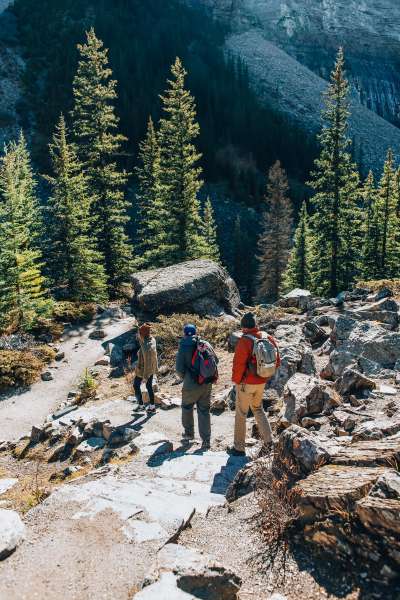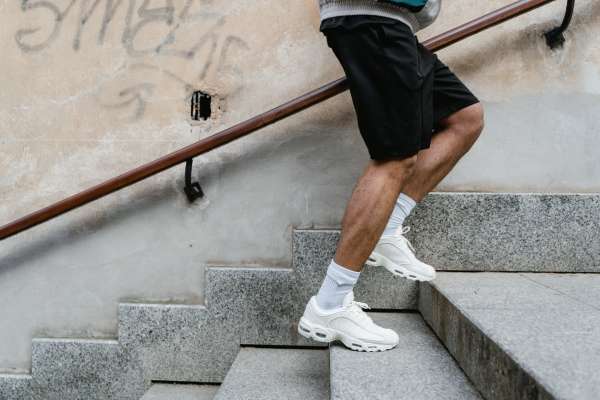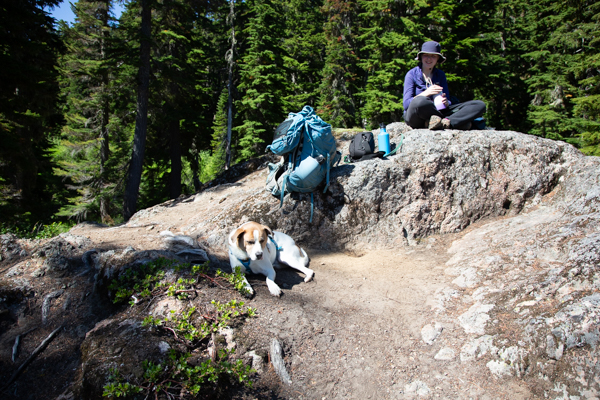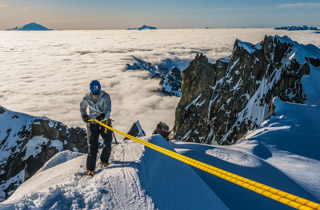Increase Hiking Speed
Increase Hiking Speed
Set Appropriate Goals
Whether you are a dedicated backpacker, an aspiring trekker, or a weekend day hiker, you probably have noticed that people hike at different rates over varying terrain. A question most of our clients ask is: How do I get faster? Let’s take a look at the many factors that go into increasing speed. But first, understand one fundamental thing first.
WHY do you want to increase your speed?
See if you relate to any of these:
- You get breathless when you’re hiking with a friend, but you don’t train much during the week. Try adding several aerobic workouts each week.
- You have planned a trip with people who have no trouble navigating difficult terrain you find challenging. Find an irregular trail with blowdowns, scree, talus, snow, roots, or boulder fields, and practice on the specific terrain that slows you down.
- You have no trouble on level terrain, but as soon as you add a pack or hills you struggle. Add targeted leg and core strengthening moves twice a week.
- You need to cover significant mileage in a limited time. Add longer and longer hikes until you can complete a few hikes at 85-90% of the total distance you’re training for.
Determine specifically what you’d like to improve, and then pick a suitable way to train from the suggestions below.


Change Training Variables
To get faster, you can manipulate any of the following variables: the weight you carry, your technical skills (i.e. getting more familiar with difficult terrain), the terrain you hike over, leg turnover rate (how fast your legs move), and the distance and elevation gain you cover.
If your goal includes being able to carry a specific pack weight for a certain amount of time, distance, or elevation gain, then you need to manipulate the weight variable. Add not more than 10% each hike to allow your body to slowly adapt to the heavier weight. Hiking with 20 pounds (10 kg) for several hours to prepare for a backpacking trip requiring that you carry 45 pounds (22 kg) for several days is NOT sufficient unless you’re okay with a lot of muscle soreness and fatigue.
If your goal includes gaining significant elevation, adjust the elevation variable by progressing your hikes systematically (see below.) But first, you need to know where you’re starting from.
Include Pacing Hikes
Assuming you already have a training base needed to start a few hikes, the easiest way to gauge your current pace and track improvement is to choose a pacing hike. Pick a trail you know, enjoy, and wouldn’t mind visiting several times a month. In early season, carry a light pack and each time you hike the chosen trail, increase the challenge. You can speed up to decrease your round-trip time, shorten breaks so you’re resting less, or add a few pounds and try to match the pace you did previously.
Try repeating your pacing hike at least once a month. Keep track of your time to desired mile markers or landmarks. If you don’t have access to sustained slopes with significant elevation gain, try repeating a shorter loop several times. If you have access to a long hill or set of stairs in town, you can use the same idea and try to reach the top a little faster each time. As you increase your aerobic endurance, you should notice an increase in speed and decrease in heart rate. Win!
Leg Turnover and Intervals
“Increasing leg turnover rate” is a fancy phrase for learning how to move your legs faster or speed up. One way to work on this is to find a steep part of the trail and power up it, rather than slowing down. Swing your arms to get more momentum and put more oomph into your movement. You can include intervals on your pacing hikes: choose a few short segments mid-way through and try pushing yourself to 90% effort. The remainder of the hike at your base pace will feel easier in comparison, and you will decrease your total time and get your legs used to walking faster.
Add Town Intervals
Another way to increase your speed is to add a weekly interval workout. Find a local hill or set of stairs that you can climb repeatedly for a set amount of time, with or without a pack. The more comfortable you are pushing yourself up steep hills or stairs, the better that training translates into faster uphill travel in the mountains.
Progress Your Hikes
A logical early season progression would be to find a few nearby hikes that give you 1200-1500’ elevation gain in 3-5 miles, 2000’ elevation gain in 5-7 miles, and 3000 gain in 6-8 miles. In the Seattle area, I recommend starting with Little Si (5 miles / 1200’ gain), then move up to West Tiger 3 (2000’ gain in 6.2 miles) and then trying Mt. Si (Exit 34; 8 miles and 3200’ gain). Some of the many conditioning hikes along the I-90 corridor include:
- Camp Muir, Mt. Rainier* 4,700’
- Mailbox Peak 4,000’
- Granite Mountain 3,800’
- Mt. Defiance 3,500’
- Mt. Washington 3,400’
- Mt. Si 3,400’
*While the hike to Camp Muir is not technical, it does require solid navigation skills. If you are not familiar with the route, we strongly encourage you to go with someone who knows the way in case of inclement weather.
Tackle Advanced Goals
If you anticipate doing a lot of outdoor adventures, you will probably want to invest in the lightest gear that your budget will allow, so weight won’t limit you. Hone your skills by taking advanced hiking, trekking, scrambling, or backpacking classes. Learn from those who do what you’d like to do. Push yourself to find and expand your own limits, setting goals beyond what you can do now – you’d be surprised what you can accomplish.

Recover Appropriately
If you are sore for several days after any of your outings, listen to your body. It is telling you that you did too much. But don’t stop moving! Get up and do a short walk or flat bike ride in the low end of your training zone to help the stiff muscles limber up while allowing you to return to activity more quickly. The worst thing you can do is wait days until the soreness passes, as that will set you back in your conditioning efforts by an entire week!
By returning to training more quickly, your body will be able to handle increased workloads with less recovery time, indicating that your fitness levels are improving that much faster. Recovery workouts should be performed at 50-60% of your maximum heart rate. DO let yourself move and see what a difference it makes.






